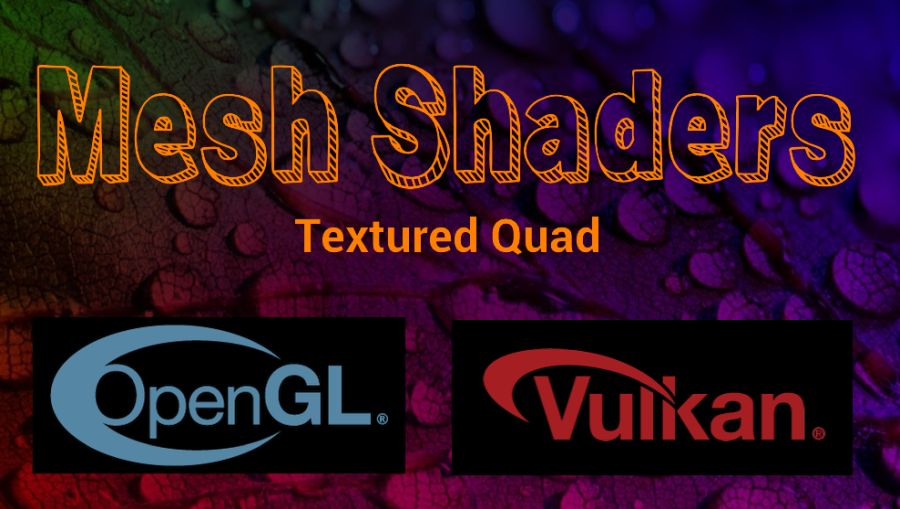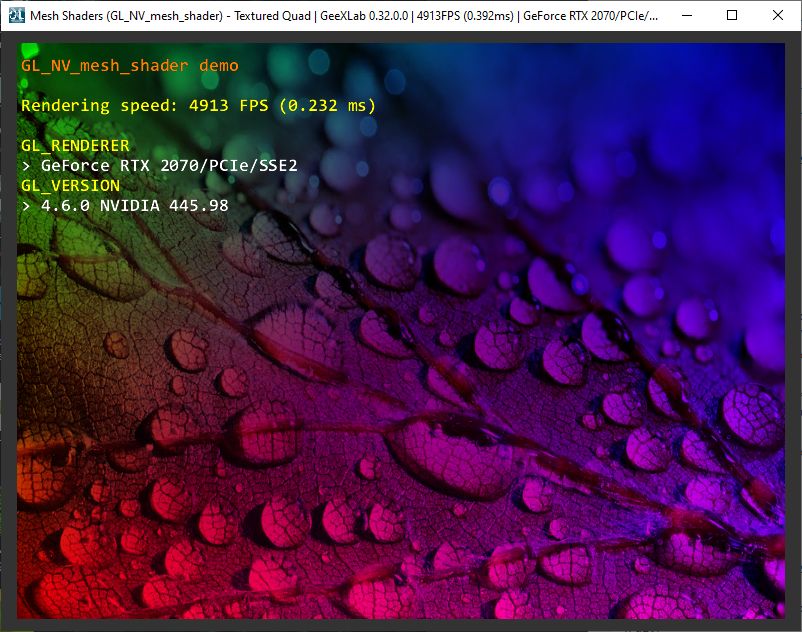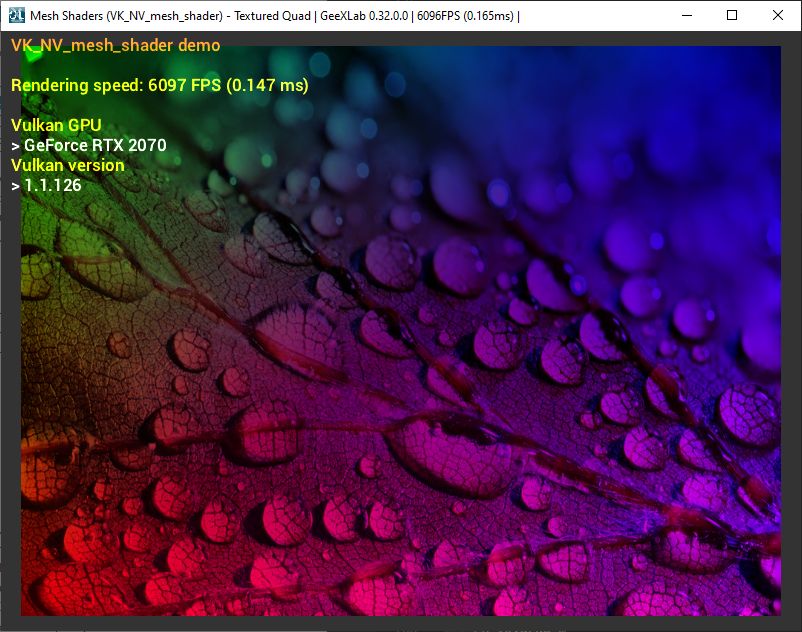
|
|
Downloads
Demos:
geexlab-demopack-mesh-shaders/gl/textured-quad/ geexlab-demopack-mesh-shaders/vk/textured-quad/ |
Rendering a textured quad with mesh shaders follows the same principle than for a RGB triangle:
– RGB Triangle with Mesh Shaders in OpenGL
– RGB Triangle with Mesh Shaders in Vulkan).
Ok there is an additional vertex and a texture, but it’s very very similar.
Here is the mesh shader, which is almost identical in OpenGL and Vulkan (in Vulkan there is an extra transformation: pos.y = -pos.y; pos.z = (pos.z + pos.w) / 2.0 for each vertex):
#version 450
#extension GL_NV_mesh_shader : require
layout(local_size_x = 1) in;
layout(triangles, max_vertices = 4, max_primitives = 2) out;
// Custom vertex output block
layout (location = 0) out PerVertexData
{
vec4 color;
vec4 uv;
} v_out[]; // [max_vertices]
float scale = 0.95;
const vec3 vertices[4] = {
vec3(-1,-1,0),
vec3(-1,1,0),
vec3(1,1,0),
vec3(1,-1,0)
};
const vec3 colors[4] = {
vec3(1.0,0.0,0.0),
vec3(0.0,1.0,0.0),
vec3(0.0,0.0,1.0),
vec3(1.0,0.0,1.0)
};
const vec2 uvs[4] = {
vec2(0.0,0.0),
vec2(0.0,1.0),
vec2(1.0,1.0),
vec2(1.0,0.0)
};
void main()
{
vec4 pos = vec4(vertices[0]*scale, 1.0);
// GL->VK conventions...
pos.y = -pos.y; pos.z = (pos.z + pos.w) / 2.0;
gl_MeshVerticesNV[0].gl_Position = pos;
pos = vec4(vertices[1] * scale, 1.0);
pos.y = -pos.y; pos.z = (pos.z + pos.w) / 2.0;
gl_MeshVerticesNV[1].gl_Position = pos;
pos = vec4(vertices[2] * scale, 1.0);
pos.y = -pos.y; pos.z = (pos.z + pos.w) / 2.0;
gl_MeshVerticesNV[2].gl_Position = pos;
pos = vec4(vertices[3] * scale, 1.0);
pos.y = -pos.y; pos.z = (pos.z + pos.w) / 2.0;
gl_MeshVerticesNV[3].gl_Position = pos;
v_out[0].color = vec4(colors[0], 1.0);
v_out[1].color = vec4(colors[1], 1.0);
v_out[2].color = vec4(colors[2], 1.0);
v_out[3].color = vec4(colors[3], 1.0);
v_out[0].uv = vec4(uvs[0], 0, 1);
v_out[1].uv = vec4(uvs[1], 0, 1);
v_out[2].uv = vec4(uvs[2], 0, 1);
v_out[3].uv = vec4(uvs[3], 0, 1);
gl_PrimitiveIndicesNV[0] = 0;
gl_PrimitiveIndicesNV[1] = 1;
gl_PrimitiveIndicesNV[2] = 2;
gl_PrimitiveIndicesNV[3] = 2;
gl_PrimitiveIndicesNV[4] = 3;
gl_PrimitiveIndicesNV[5] = 0;
gl_PrimitiveCountNV = 2;
}
And here is the pixel shader, for both APIs:
#version 450
layout (location = 0) in PerVertexData
{
vec4 color;
vec4 uv;
} fragIn;
layout (binding = 0) uniform sampler2D tex0;
layout (location = 0) out vec4 FragColor;
void main()
{
vec2 uv = fragIn.uv.xy;
uv.y *= -1.0;
vec4 t = texture(tex0, uv);
FragColor = fragIn.color * t;
}
In the Lua side, the code is nearly similar, the little difference is the texture: in OpenGL the texture has to be bound before rendering while in Vulkan the texture is a resource added to the descriptor set used by the pipeline.
The drawing code in the OpenGL demo:
gh_texture.bind(tex, 0)
gh_gpu_program.bind(nv_mesh_prog)
gh_renderer.draw_mesh_tasks(0, 1)
OpenGL demo:

The drawing code in the Vulkan demo:
gh_vk.descriptorset_bind(ds)
gh_vk.pipeline_bind(mesh_pipeline)
gh_vk.draw_mesh_tasks(0, 1)
Vulkan demo:
